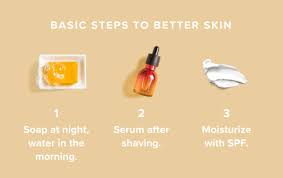
Best Skincare Routine for Men – A Dermatologist’s Guide to Healthy Skin
Whether you’re 15 or 55, having the right skincare routine is essential for healthy, clear, youthful-looking skin.
As a dermatologist, I often tell my male patients: the earlier you start caring for your skin, the better the results you’ll see long-term.
In this guide, I’ll walk you through how to build a customized skincare routine for men—based on your Baumann Skin Type®, age, and specific skin concerns like acne, oiliness, redness,
razor irritation, wrinkles, or hyperpigmentation.
🧬 Why Men Need a Personalized Skincare Routine
Most off-the-shelf products don’t account for your unique skin biology. Men’s skin is typically thicker, oilier, and more prone to irritation from shaving—but that doesn’t mean all men need the same products.
The key is knowing your Baumann Skin Type. There are 16 scientifically validated types, and each one requires different ingredients and formulations.
Take the Baumann Skin Type® Quiz to get personalized product recommendations based on your skin’s hydration, sensitivity, oil levels, and pigmentation risk.
🧼 Basic Skincare Routine for Men: CPR Method
If you want a simple, effective skincare routine, start with the CPR method:
Cleanse, Protect, Repair
These are the three non-negotiable steps in any effective skincare routine—whether you’re a beginner or already skincare-savvy.
1. Cleanse
Your cleanser sets the tone for your routine. It removes oil, dirt, and pollution while prepping your skin for treatment products.
Choose your cleanser based on your skin type:
Foaming cleanser – for oily, acne-prone skin
Creamy or oil-based cleanser – for dry, sensitive, or mature skin
Low-pH or soothing cleanser – for redness, stinging, or inflammation
Learn more:
Why You Might Need 2 Different Cleansers
What’s the Best Water Temperature to Wash Your Face?
2. Protect
The most important product in your morning routine is sunscreen. UV exposure accelerates aging, worsens dark spots, and triggers inflammation—even on cloudy days.
🧴 For a low-maintenance routine, use a moisturizer with built-in SPF. It hydrates and protects in one step.
3. Repair
This step targets your specific skin problems—like acne, oiliness, redness, or aging.
Use treatment serums and moisturizers with proven ingredients such as:
Retinoids (for aging, acne)
Niacinamide (for oil and redness)
Peptides (for wrinkles)
Azelaic acid (for acne and pigmentation)
🧖♂️ Complete Skincare Routine for Men (Advanced)
If you’re serious about improving your skin, a comprehensive regimen will give you faster, more visible results.
➕ Full AM Routine for Men:
Cleanser
Shave (if applicable), Cleanse again, Eye cream, Treatment serum, Moisturizer, Sunscreen
🌙 Full PM Routine for Men:
Cleanser, Eye cream, Treatment serum (e.g., retinol), Moisturizer
💡 Tip: If you’re using products with actives (like retinol or peptides), the order of application matters. Some ingredients can cancel each other out if layered incorrectly.
👦 Skincare for Men Ages 15–30
At this age, the biggest concerns tend to be acne, oiliness, and sun damage. But many young men also experience sensitive skin, dehydration, or post-shave irritation.
Cleansers for Young Men
Oily/Acne-Prone Skin: Look for salicylic acid to help unclog pores.
Dry/Sensitive Skin: Avoid foaming cleansers. Use a hydrating creamy cleanser or cleansing oil.
Moisturizers for Young Men
Oily Skin: Lightweight, oil-free, noncomedogenic moisturizers.
Dry Skin: Rich barrier-repair moisturizers with lipids and ceramides.
Sunscreen for Young Men
Choose a lightweight, noncomedogenic SPF that you’ll actually wear daily.
Popular untinted mineral SPFs for men:
Even if you’re acne-prone or oily, skipping sunscreen will make breakouts worse and speed up aging.
👨🦳 Skincare for Older Men (30+)
From age 30 on, men start to experience collagen loss, deeper wrinkles, and uneven skin tone. If you’ve had significant sun exposure, now’s the time to start using anti-aging ingredients.
Best Anti-Aging Ingredients for Men:
Retinoids – Boost cell turnover, reduce wrinkles and acne
Peptides – Help firm and smooth skin
Niacinamide – Reduces inflammation and discoloration
Vitamin C – Brightens skin and protects from free radicals
⚠️ Not all older men have the same skin issues. There are 8 wrinkle-prone skin types in the Baumann system. Take the quiz to match the right ingredients to your type.
Beginner-Friendly Retinoids for Men:
Start using retinol 2–3 times per week at night, and always combine with a moisturizer to prevent dryness.
👨⚕️ Common Skin Concerns in Men and How to Treat Them
Here’s how your skincare routine can target multiple issues:
Concern Ingredients to Look For
Acne Salicylic acid, benzoyl peroxide, retinoids
Oiliness Niacinamide, zinc, oil-free moisturizers
Dryness/Dehydration Ceramides, glycerin, hyaluronic acid
Shaving irritation Panthenol, allantoin, chamomile extract
Redness/Rosacea Azelaic acid, metronidazole, probiotics
Wrinkles & sagging Retinoids, peptides, antioxidants
Hyperpigmentation Vitamin C, retinoids, azelaic acid
You can’t treat everything in a basic 2-step routine. That’s why it’s important to prioritize based on your skin type—and add more steps gradually as your skin adjusts.
💡 Bonus Tips for Men’s Skincare
Shaving & Skincare: Shave after cleansing, but rinse again to remove shaving cream residue. Use a soothing aftershave balm if you’re prone to irritation.
Order matters: Apply treatment serums before moisturizers. Sunscreen is always last in your AM routine.
Don’t guess your skin type: Studies show over 50% of people guess wrong. Take the quiz for accurate product matching.
Be consistent: It takes 4–8 weeks to see results from most active ingredients like retinol or niacinamide.
🧪 Build Your Personalized Skincare Routine for Men
The best men’s skincare routine is the one tailored to your skin’s biology. Our skin type quiz helps you:
Identify your skin type
Get a personalized skincare plan
Choose the right ingredients
Avoid wasting money on the wrong products
Thousands of doctors around the world trust the Baumann Skin Type System®—now you can, too.
🚀 Ready to Get Started?
👉 Take the Baumann Skin Type Quiz to discover your exact skin type
🧴 Build your personalized regimen based on your results
📩 Get dermatologist-backed advice sent straight to your inbox
Investing in your skin pays off at every age. Whether you want to prevent aging, reduce breakouts, or just look more polished—let’s build a skincare routine that works for you.


